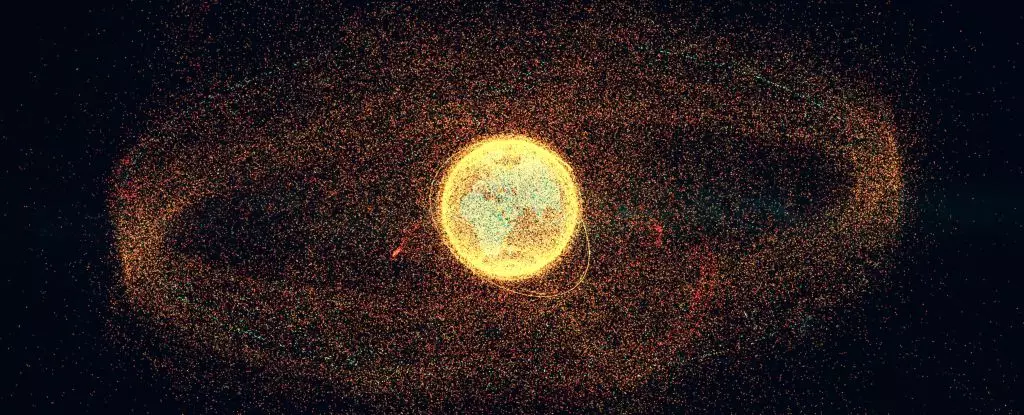The alarming rise of space debris presents a multifaceted challenge that humanity can no longer afford to ignore. Each year, the European Space Agency (ESA) highlights this escalating issue in its Space Environment Report, proving that we are sending satellites into orbit at an unsustainable pace. This rapid deployment has led to a significant imbalance: the number of defunct satellites and debris outnumbers functioning ones at a staggering rate. If we continue on this trajectory, Earth’s orbit could soon resemble a hazardous minefield, where items collide with each other, generating even more debris in a runaway effect known as the Kessler syndrome.
At present, the numbers tell a bleak story. ESA estimates suggest that about 40,000 objects are currently being monitored in orbit around the planet, with only 11,000 of these being operational satellites. The rest are relics of past ventures, broken spacecraft, and bits of debris that contribute to the mounting risk of collision. The overabundance of space junk has implications not just for future missions but also for existing assets like the International Space Station (ISS) and the Hubble Space Telescope. These missions are not merely scientific endeavors but essential components of our understanding of the universe. As the debris field thickens, the margin for error shrinks perilously.
The Fragile Nature of Ongoing Missions
The consequences of space debris extend beyond mere statistics; they impact crucial scientific research and technology that humanity relies on. The risks posed by non-collisional fragmentation events add another layer of complexity to an already precarious situation. According to ESA reports from 2024, the most significant number of space debris events stemmed from spontaneous processes, none of which can be anticipated or mitigated. The occurrences led to thousands of pieces of debris being unleashed into orbit—fragments that can wreak havoc on functional satellites, leading to catastrophic failures and loss of data critical to technological and scientific advances.
Despite this troubling landscape, the urgency surrounding the management and removal of space debris is gaining traction. A key takeaway from ESA’s findings is that debris isn’t just something we can ignore; it requires active engagement and cleaning efforts to prevent the orbits from deteriorating further. Projects aimed at removal strategies have been initiated, and scientists are calling for more rigorous policies to be put in place—especially given that monitoring alone is insufficient. The time has come for humanity to take cooperative action rather than merely react to damage caused by existing debris.
Opportunity Amid Crisis: The Case for Global Cooperation
While the daunting statistics about space debris paint a grim picture, they also present an opportunity for international collaboration. The ESA has indicated some progress: more than half of rocket stages and satellites were disposed of in a controlled manner in recent years, which marks a refreshing change in strategy. These developments show that solutions are not just theoretical; they’re becoming practical realities that can significantly mitigate debris creation. Compliance with new guidelines, such as vacating space within reduced timelines, is crucial to fostering a sustainable orbital environment.
In an era defined by global challenges—climate change, pandemics, and geopolitical tensions—space debris should be a unifying issue that transcends borders. The cooperation required for meaningful cleanup efforts necessitates sharing resources, technology, and strategies. Collaboration in space debris mitigation can set a precedent for how countries work together to address large-scale challenges, proving that we can put our differences aside when facing a mutual threat.
Despite progress, this cooperation must accelerate. Relying on piecemeal solutions is inadequate; we need comprehensive, sustainable strategies formulated through concerted international dialogue and commitment. Innovative technologies such as robotic arms and nets designed to capture debris could benefit from funding and collaboration from multiple nations.
The Moral Imperative of Space Stewardship
Ultimately, our responsibility extends beyond just the Earth; it encompasses the celestial realms we have only begun to explore. With each satellite we send into orbit, we are carving out humanity’s legacy in the cosmos—a legacy that could either inspire generations or lead them to inherit a chaotic mess of debris. Therefore, we stand at a moral crossroads, where the decisions we make now will shape not just our future in space but also our ethical imperative to preserve it for future explorers.
With the risks rising and the window for meaningful action closing, it is crucial that stakeholders—including governments, private companies, and space agencies—work together toward viable solutions. Protecting Earth orbit is not merely a technical challenge; it is a testament to our capacity for cooperation, foresight, and responsible stewardship of our shared home in the universe. Failure to act could lead us toward a scenario where space is more of a hostile environment than a gateway to our future.

